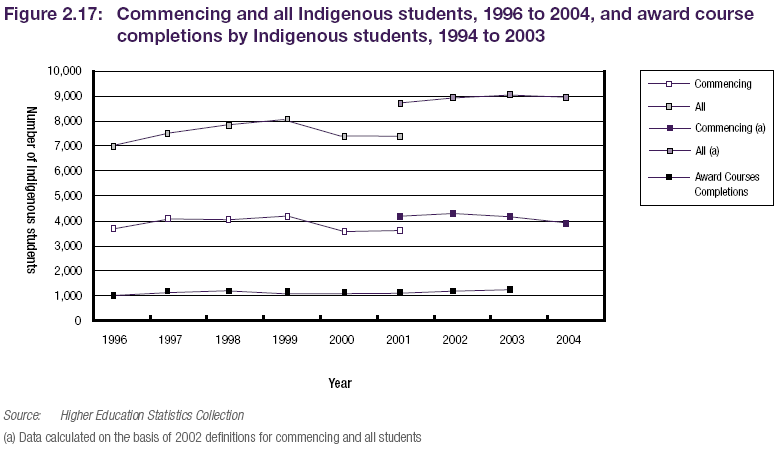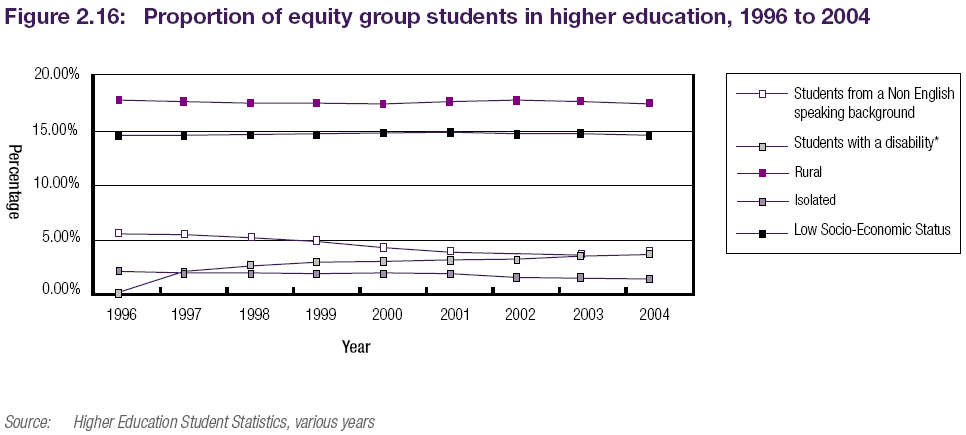|
Higher Education Report 2004-05 |
The recently released Higher Education Report 2004-05 paints a dismal picture for equity of access to university education in Australia, and indications are that it's getting worse.
It is probably too early to determine the full impact of the Our Universities: Backing Australia's Future changes on the participation of equity groups, but the Department of Education, Science and Training's (DEST) latest report confirms the thoroughly established trend of the past decade – stagnation (with the partial exception of women studying in non-traditional areas). In graphical form, the figures for Indigenous student participation over the past 10 years show a few bumps, but the net result, once again, is stagnation.

[Graph from Higher Education Report 2004-05, p. 33]
The report states that Indigenous students represented 1.2% of all domestic students in 2004, but it would take "a figure closer to 2.5 per cent [to] close the gap between Indigenous and other Australians in higher education relative to population numbers"1. In other words, since 1997, when Indigenous student representation had grown to 1.3% relative to the 1.8% of Indigenous people in the general population, their relative representation has declined to less than half of what it should be -- and we don't want to talk about it.
DEST's statistics show that in 2004 the lowest number of Indigenous students in a decade commenced higher education, after a 5% decline from 2003. The participation of students from low “socio-economic status” (SES) backgrounds declined slightly from 2003 (14.5%) to 2004 (14.1%), because of the lowest number of commencing students from low SES backgrounds since 1998. This participation rate is well below the general population benchmark of 25%.
2004 was also a record low year for students from isolated areas, with the lowest number of commencing students and the lowest total number of isolated students in higher education in a decade.
The report generously describes the “success” of equity groups since 1996 as "varied"2 and insightfully declares that "increasing access continues to be the key issue for improving equity outcomes"3. What the report fails to mention are the issues that impact on access – negatively or positively – and the failure of the Coalition's policies to improve access for most equity groups over the past nine years.

[Graph from Higher Education Report 2004-05, p. 31]
The absence of any expression of concern about the ten year low figures for Indigenous and isolated students' participation is extremely worrying. But, the Minister, Dr Brendan Nelson, in the foreword to the report assures us of his understanding of the need to "…ensure that the decisions we make in allocating resources are helping to achieve the government's aim of a higher education sector which is sustainable, diverse, of high quality and which provides equity of access"4.
However, the absence from the report of items such as benchmark figures for students from “Rural and Isolated” areas, students with a disability, or for students from non-English speaking backgrounds raises the question – why were they left out and is it indicative of an increasingly bold neglect of equity issues BY THE GOVERNMENT?
Student income support measures which are known to improve participation by disadvantaged groups,
were examined earlier this year by a Senate inquiry established by Senator Stott
Despoja. The government agreed to 7 of the committee's 15 recommendations,
including an independent review of the effectiveness of the student income
support system, and improved data collection and reporting.
The evidence presented to the inquiry
implores an immediate start of the independent review, but as yet there is no
sign on the Government's part to undertake the review.
While the government response to such an inquiry is likely to be minimalistic at best, the delay in commencement of the review indicates just where equity of access lies in Minister Nelson's list of priorities for the higher education sector.
The big items currently on his agenda – such as the Research Quality Framework, new workplace reform requirements, changes to the accreditation arrangements for universities, re-aligning Commonwealth-State responsibilities for the sector and enhancing offshore quality – will have little direct impact on equity. The Minister’s push to introduce Voluntary Student Unionism (VSU) is the exception to this. Overwhelming evidence was presented to two Senate inquiries [Inquiry into Student Income Support, Inquiry into the Provisions of the Higher Education Support Amendment (Abolition of Compulsory Up-front Union Fees) Bill 2005] about the negative impacts VSU would have on disadvantaged students.
The cost shifting exercise of expanding the numbers of international students, fee-paying postgraduate coursework students and domestic undergraduate full fee-paying students together with the 25% increase in HECS, shows the government's drive to further divest itself of higher education expenditure. This is bad news for equity, because a serious injection of funds into the student income support system and various equity programmes will be needed if we are to ever see real equity of access across our entire population.
Were the minister to show a serious interest in undertaking reforms to promote equitable access to higher education, Dr Nelson could expect a more welcoming reception when attempting to deliver a speech on university campuses.
-
Higher Education Report 2004-05, p.32
-
ibid. p. 31
-
ibid. p. 31
-
ibid. p. XI
Peter Vanderaa was the Australian Democrats' education adviser from September 2003 to June 2005. He is currently working at the Queensland Government's Department of State Development, Trade and Innovation.
 Peter
Vanderaa Discusses Equity and the
Peter
Vanderaa Discusses Equity and the